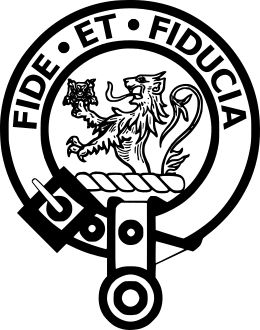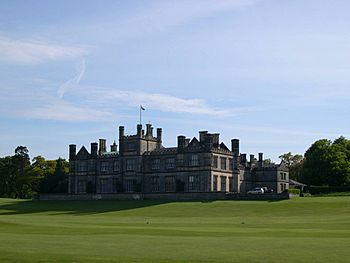Clan Primrose facts for kids
Quick facts for kids Clan Primrose |
|
|---|---|
 |
|
| Motto | Fide et Fiducia (By Faith And By Trust) |
| Chief | |
 |
|
| The Right Honourable Neil | |
| Earl of Rosebery and Midlothian | |
| Seat | Dalmeny House |
Clan Primrose is a Lowland Scottish clan. This means it's a group of families from the flat, southern parts of Scotland who share a common history and often a chief.
Contents
History of Clan Primrose
Where Did the Name Primrose Come From?
The name Primrose comes from an area of land called Primrose. This land was in the parish of Dunfermline, in a place called Fife. The original farm building was located where Grange Road and Primrose Lane meet today, in what is now a town called Rosyth.
The name "Primrose" might come from old Pictish words. *Pren meant "tree," and *ros meant "moor" (a type of open, wild land). Another idea is that the first part, *prim, meant "first."
The first known ancestor of the Earls of Rosebery was Henry Primrose. He was born before 1490 and lived near Culross Abbey. Henry's son was Gilbert Primrose (surgeon). Born around 1535, Gilbert became a surgeon to King James VI of Scotland.
The 1600s and the Civil War
Gilbert the surgeon's son was Gilbert Primrose (minister). He was a minister in a reformed church in Bordeaux, France. Later, he worked at the French Protestant Church in London. He became a chaplain to King James VI and later to King Charles I of England. In 1628, he became the Dean of Windsor.
Another important family member was James Primrose (died 1641). He was a clerk for the Privy Council of Scotland. This council was a group of advisors to the King. James had many children. One of his sons was named Archibald.
James Primrose passed away in 1641. His son, Archibald Primrose, Lord Carrington, took over his role as Clerk to the Privy Council. Archibald supported the King's side during the English Civil War. This war was fought between those who supported the King (Royalists) and those who supported Parliament.
Archibald joined James Graham, 1st Marquess of Montrose, a famous Royalist leader. He was captured after the Battle of Philiphaugh. Archibald was found guilty of treason, which means going against the King. However, his life was saved. He was held in prison until Montrose's army was told to leave the kingdom. Archibald was later set free and made a knight by the King.
In 1648, Archibald joined a plan to help King Charles I escape. This plan failed. But Archibald survived and joined Charles II of England in 1651. He fought in the Battle of Worcester. After this, King Charles made him a baronet, which is a special title. The King then had to leave the country. Archibald's family lands were taken away.
After the King returned to power in 1660 (this was called the Restoration), the Primrose lands were given back. Archibald Primrose became a judge and a high-ranking official in Scotland. He was known as "Lord Carrington." He later bought the lands of Barnbougle and Dalmeny. These lands are still the family's home today.
The 1700s
Lord Carrington's son, Sir William Primrose, took over. His son, Sir James Primrose of Carrington, became a Member of Parliament for Edinburgh in 1703. In the same year, he was given the title of Viscount Primrose.
The second Viscount died young and had no children. His brother, Hugh, the third Viscount, also had no children. So, the title passed to another branch of the family.
Archibald Primrose (born 1664) was the only son from Lord Carrington's second marriage. He inherited the Dalmeny estate. He became a Gentleman of the Bedchamber for King William of Orange. From 1695 to 1700, he was a Member of Parliament for Edinburgh. He was also given the titles Viscount of Rosebery, Lord Primrose, and Dalmeny. When Anne, Queen of Great Britain became Queen, he was made an Earl.
He was a Privy Councillor in 1707. He also helped with the Treaty of Union, which joined Scotland and England to form Great Britain. After the union, he was one of the sixteen Scottish peers chosen to represent Scotland in the House of Lords.
Sir Archibald Primrose of Dunipace was executed in 1746. This was because he supported the Jacobites. The Jacobites were people who wanted the old royal family (the Stuarts) to be kings again.
The third Earl of Rosebery was a representative peer. This meant he was one of the Scottish nobles who sat in the House of Lords. He was also made a Knight of the Thistle in 1771. This is a very important Scottish honor.
The 1800s
Archibald John was the fourth Earl of Rosebery. He was a Member of Parliament for Hellston and later for Carlisle. In 1828, he was made a baron of the United Kingdom with the title 'Lord Rosebery'. In 1840, like his father, he was made a Knight of the Thistle. Three years later, he was appointed Lord Lieutenant of Linlithgowshire. This was a royal representative in the area.
Clan Seat
The main home of the Chief of Clan Primrose is Dalmeny House. It is located in West Lothian, Scotland, right by the Firth of Forth.
Clan Chief
The current leader of Clan Primrose is Neil Primrose, 7th Earl of Rosebery.
See also


